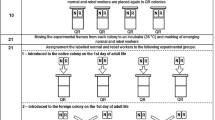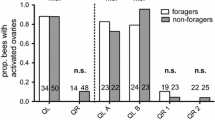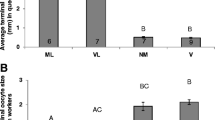Abstract
Honey-bee (Apis mellifera) colonies exhibit extreme reproductive division of labour. Workers almost always have inactive ovaries and the queen monopolises egg laying. Although extremely rare, ’anarchistic’ colonies exist in which workers produce male offspring despite the presence of the queen. By comparing the rates of ovary activation in anarchistic and wild-type bees fostered to host colonies of different genotype (i.e. anarchist and non-anarchist) and queen status (i.e. queenless and queenright), we investigated the factors involved in inhibiting ovary activation. Fostered anarchist workers always had a higher level of ovary development than fostered wild-type bees in both anarchist and non-anarchist host colonies. Fostered workers of both genotypes had more active ovaries in anarchistic than in wild-type hosts. Fostered workers of both strains also had more active ovaries in queenless than in queenright hosts. The results suggest that selection for worker reproduction in the anarchistic line has both reduced the effects of brood and queen pheromones on worker ovary inhibition and increased the likelihood that workers of the anarchistic line will develop ovaries compared to wild-type workers.
Similar content being viewed by others
Author information
Authors and Affiliations
Additional information
Received: 14 June 2000 / Revised: 26 September 2000 / Accepted: 7 October 2000
Rights and permissions
About this article
Cite this article
Barron, A., Oldroyd, B. Social regulation of ovary activation in ’anarchistic’ honey-bees (Apis mellifera). Behav Ecol Sociobiol 49, 214–219 (2001). https://doi.org/10.1007/s002650000278
Issue Date:
DOI: https://doi.org/10.1007/s002650000278




